SUMMARY
Hardy Kiwifruit plants grow well in temperate climates such as those found in the Midwestern U.S. The plants are very hardy surviving winter temperatures less than -25 degrees F and summer heat in excess of 100 degrees F. They grow as long vines that do best when grown on sturdy trellises. Once plants are established, growth is vigorous, such that shoots of new growth will occur all along the vines and this growth may extend 5-10 feet by the end of the season. As a result, summer pruning is essential to keep the vines from overgrowing and trained within the space desired.
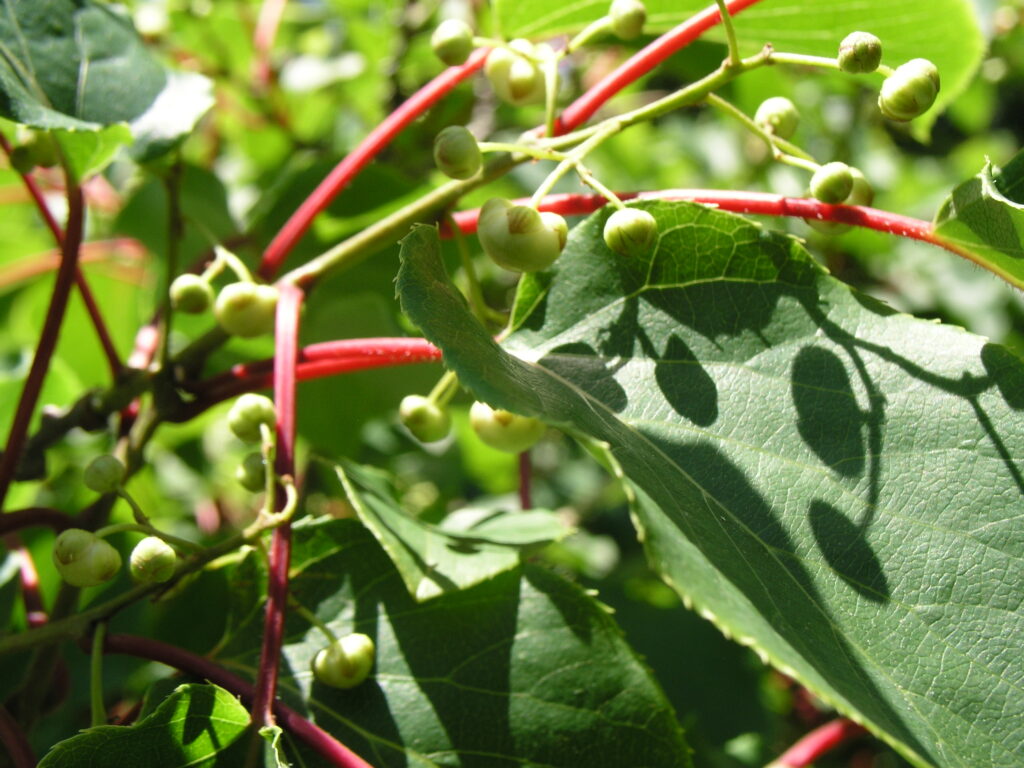
Fruit grows on female plants only and their flowers require pollination from a flowering male plant nearby (within 50-100 feet away) as a source of pollen. Bees and native pollinators are very active pollenizers. Fruit grows in clusters of 5-20 or individually on vines and it ripens in early to mid-October. It is common to harvest 1-2 gallons of fruit from each mature female plant. Plants live a long time, well over 20 years.
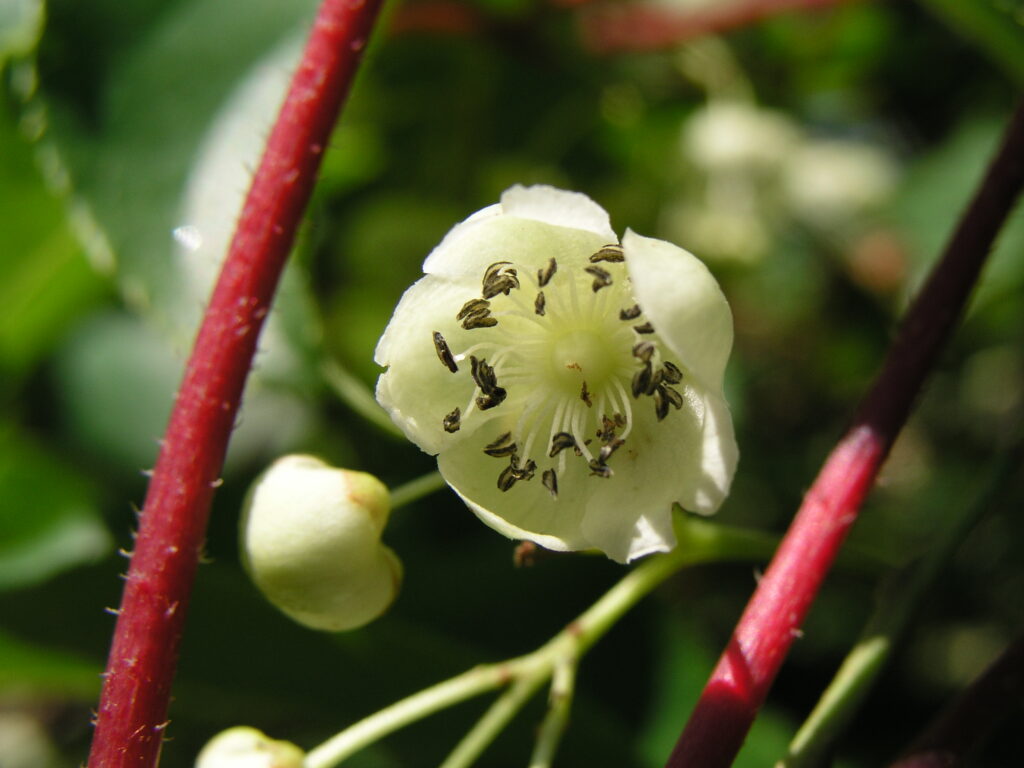
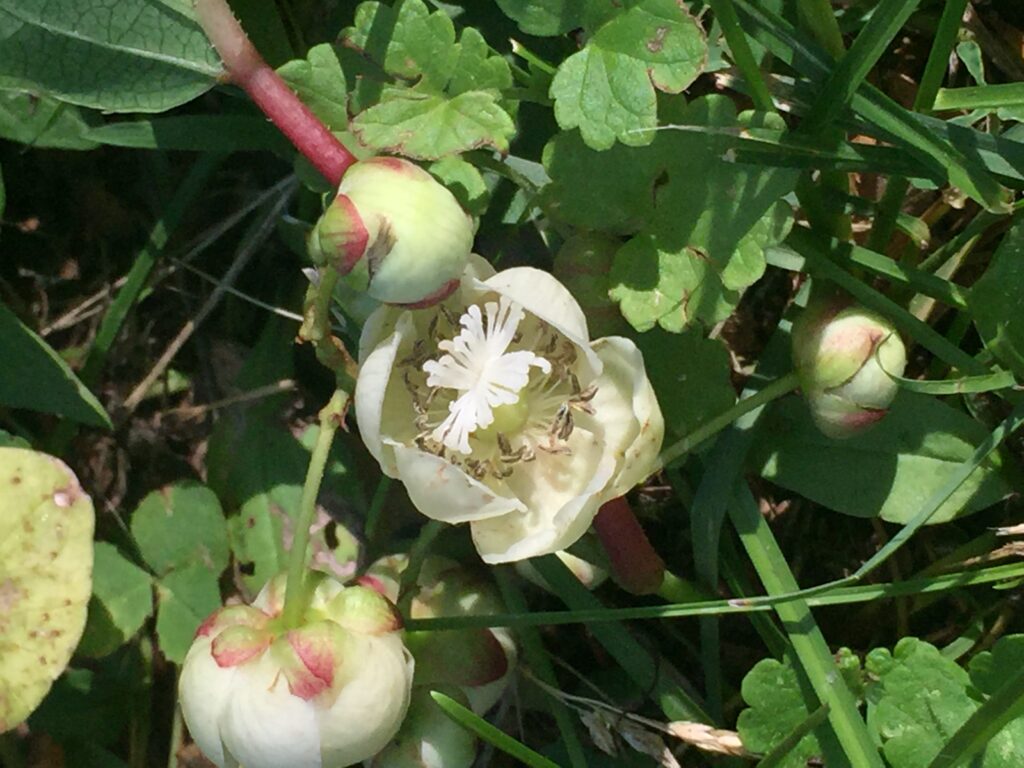
Unlike the fuzzy New Zealand Kiwis, kiwifruit has a thin, smooth skin without fuzz. It is usually 3/4 to 1.5 inches in diameter and is sweeter than New Zealand Kiwis having a Brix greater than 21%. They can be picked 2-3 weeks before ripening and stored refrigerated for 1-2 months. On the kitchen countertop, they will ripen to full flavor and sweetness in a week or so. Flavor and appearance are very similar to those of New Zealand kiwis.

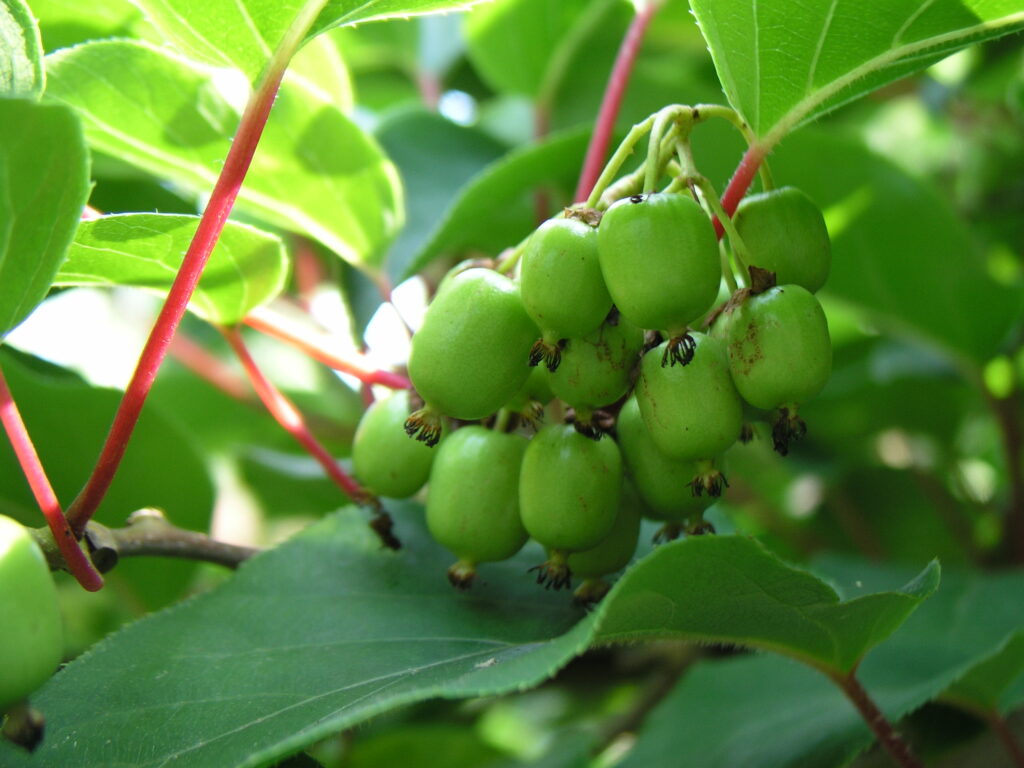
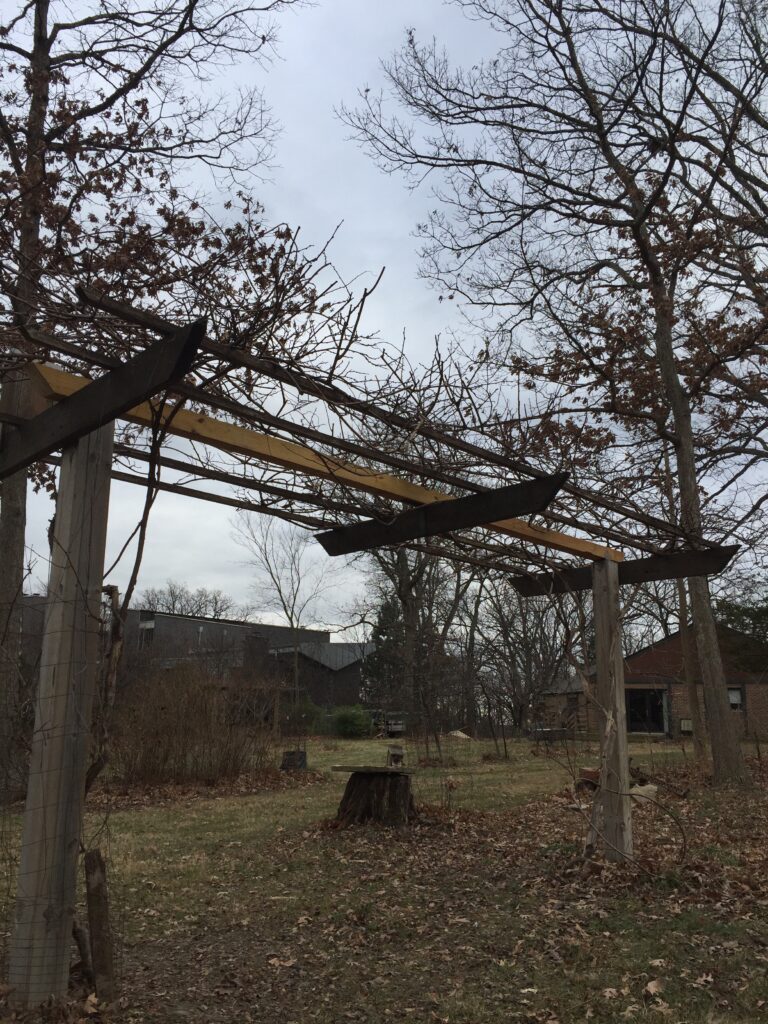
There are very few insect pests of Hardy Kiwi, but occasionally a small number of fruit may be damaged by Japanese beetles or by stinkbugs. Squirrels generally do not bother the fruit, but raccoons may attack the fruit just before full ripening occurs. As for care of the plants, during very dry or hot weather, sufficient water needs to be provided in order to avoid fruit drop.
http://hwwff.cce.cornell.edu/content/crop-fact-sheets/hardy-kiwi.pdf
Hardy kiwi (Actinidia arguta, Actinidia kolomikta)
By Gary Micsky
Hardy kiwi is a cousin of the brown fuzzy kiwi seen in most supermarkets today. Although not nearly as large as its relative, it does have some potential as a crop in the northeast. While there are concerns over cold hardiness of the shoots, experimentation by those willing to invest the time may yield promise.
Although the kiwi fruit, once referred to as the “Chinese gooseberry,” has been grown and collected from the wild for centuries in Asia, it only recently has become commonly available in the Western world. This hen’s-egg-sized fruit is covered with a brown fuzzy skin and has a melting green and very tasty pulp. This type of kiwi, which we can purchase readily from our grocery stores, can not be grown in Pennsylvania because of its cold tenderness and long growing season. A cousin of this kiwi, though, the hardy kiwi (Actinidia arguta, Actinidia kolomikta), is much more cold hardy than the plant of the commercially available fruit. It is the subject of considerable interest in our region due to its lovely flavor, relatively smooth (and edible) skin, “out of hand” eating size (about the size of a large grape), and its good shelf life. Although commercial plantings have been established in several locations in Pennsylvania, the growing of hardy kiwi remains an experiment.
Hardy kiwis have some horticultural limitations that need to be addressed by the prospective grower.
–Male and female flowers are borne on different plants, so both males and females must be planted in roughly a 1:6 ratio of males to females.
–The plants often take several years to mature, and usually do not bear fruit until they are 5 to 9 years old.
–Although the plants are extremely winter hardy, tolerating temperatures as low as -30°F, they develop shoots early in the spring that are extremely sensitive to frost. In most years, we see some shoot burning” due to frost, although the plant usually survives, re-grows, and fruits despite some spring shoot removal. If flowers are frosted, fruit will not develop that year.
–Hardy kiwi are extremely vigorously growing vines, requiring a substantial supporting trellis. Despite the challenges, once one has sampled the fruit, kiwi growing seems well worth the trouble. The fruit is aromatic, with fuzzy kiwi, banana, strawberry and pear flavors all wrapped up in one delightful package.
Ananasnaya: A Russian cultivar, this name means “pineapple-like”. Because of the tongue twisting name, many nursery catalogs will refer to this cultivar as “Anna”. The fruit is of very good quality, with a sweet aroma and intense flavor. The skin is green and develops a purple-red blush in the sun. A very vigorous vine, this cultivar is currently the only standard that we have to compare to others.
Meader: Available as both a male and a female. Make sure to order the female if you want fruit from it. The fruit is medium sized.
Geneva: Several Geneva selections are available through nurseries. Although they are not widely tested, it is known that the fruit ripens earlier than either Anna or Issai, and that it has a good flavor.
Issai: The only self-fertile cultivar (not requiring a male pollinator), this variety has not performed well in Pennsylvania. It is from Japan and is less vigorous than other hardy kiwi cultivars, with small fruit and good flavor. Harvesting it is a challenge because the fruit ripen unevenly within a cluster.
Planting and Establishment
Vines usually are purchased from nurseries as rooted cuttings or as potted plants. Order male plants that flower at the same time as your female cultivars. Dormant rooted cuttings should be planted 10 feet apart as soon as the soil can be worked in the spring. The planting row width, if rows are used, will depend on the type of trellis and the equipment used in the planting. Containerized plants may be planted in the spring after the danger of frost is past. Distribute male plants throughout the planting. When planting, you may need to trim the roots. Plant vines just deeply enough to cover the roots well with soil, and water well. Irrigate throughout the season as needed, and monitor for insect and disease pests.
Nutritional Requirements
Because hardy kiwi roots burn rather easily, apply fertilizer cautiously. No fertilizer will be necessary in the year of planting. In the spring of the second year, apply 2 ounces of 10-10-10 per plant, and increase this amount by 2 ounces each year until plants receive a total of 8 ounces per plant.
Pruning and Training
Figure 1: Kiwi vines trained to a pergola (T-bar) trellis. (Courtesy Oregon State University)
Figure 2: A fruiting branch of hardy kiwi. (To simplify the figure, leaves are not shown.) Fruits are produced on shoots growing from last year’s growth.
Winter pruning cuts are shown by //. (Courtesy Oregon State University) In order to manage the high level of vigor of the hardy kiwi vine, plants must be pruned and trained. Like most perennial fruit plants, they require dormant pruning; however, they also need to be pruned several times during the summer, by cutting back the terminal growth to four to six leaves beyond the last flower. Also remove watersprouts (vigorous shoots originating from older wood) and shoots from the trunk, as well as vines that become entangled. This removal may be substantial during the summer.

Dormant pruning should be done sometime from December to March in Pennsylvania. On this species, flowers develop on current-season shoots that come from 1-year-old canes (last year’s growth); shoots from older wood rarely produce flowers. As with grapes, a large percentage of the wood—as much as 70 percent—will be removed. New fruiting canes will have developed at the base of last year’s growth (Figure 12.1).
Replacement canes are left for future fruiting, and fruiting canes should be spaced between 8 and 12 inches on the cordons (permanent horizontal branches). Training should begin in the first year of planting. Like grapes, these flexible vines can be maintained to a number of forms; although in commercial plantings, a pergola (Figure 12.2) is the most common training system, since it accommodates the kiwi’s high level of vigor. Also, like grapes, establishing the trunks and structure of the vine early in its development will ensure fruit production for many years to come. Figure 12.3 shows a typical hardy kiwi plant training system over the first 2 years of its life. For further inspiration, see the training systems in Chapter 6 of Penn State Small Scale Fruit Production Guide http://ssfruit.cas.psu.edu/chapter6/chapter6a.htm.

Figure 3: First two years of training a kiwi vine. (Courtesy of Oregon State University) (A) Prune to two buds at planting. (B) Train one shoot as trunk, remove all others (growing season, year 1). (C) Head back trunk as shoot growth at terminal loses vigor (growing season, year 1). (D) Continue to remove lateral shoots, let trunk grow beyond wire, then head to just below top wire (growing season, year 1). (E) Choose two shoots to form cordons (lateral trunks). Head back to 1/4 inch diameter in dormant season (growing season, year 1). (F) Shoot growth, year 2. Pruning cuts in dormant season of year 2 also are shown by //.
Harvest and Post Harvest
A single mature hardy kiwi plant will yield between 50 and 100 pounds of fruit. Hardy kiwi can be allowed to “vine ripen,” at which time they will have about 18 to 25 percent sugar. At this time, a single harvest, rather than a selective one over several pickings, is acceptable. Unlike the other small fruits, hardy kiwi will “after-ripen.” Specifically, they can be harvested at a less-than-optimal ripeness (about 8 to 9 percent sugar) and then placed in storage to ripen. When picked in this manner, hardy kiwi will keep in a cooler for up to 2 months.